fuel consumption Citroen C4 2015 2.G Owner's Manual
[x] Cancel search | Manufacturer: CITROEN, Model Year: 2015, Model line: C4, Model: Citroen C4 2015 2.GPages: 494, PDF Size: 20.49 MB
Page 12 of 494
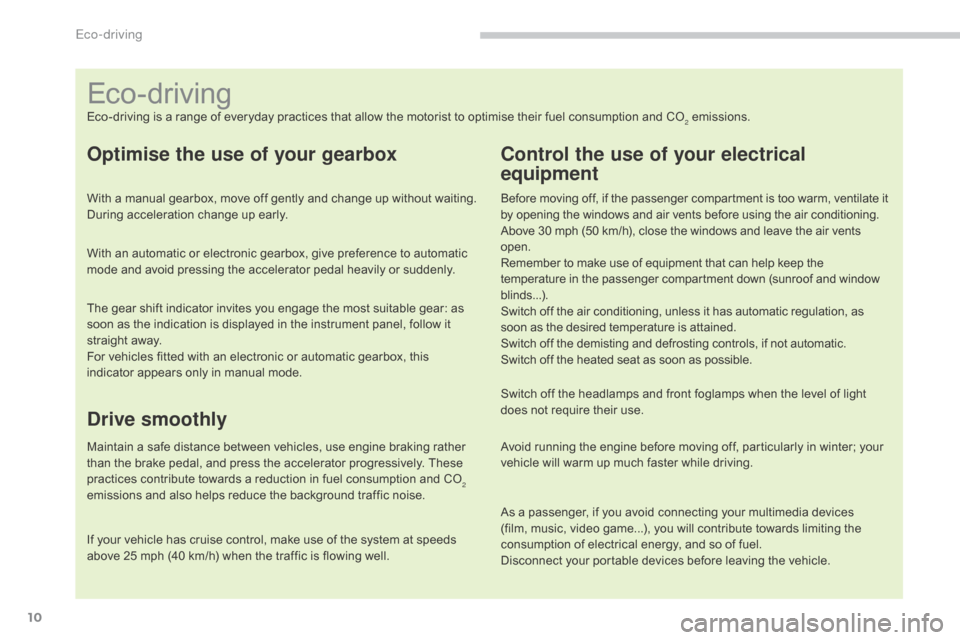
10
C4-2_en_Chap00c_eco-conduite_ed01-2015
C4-2_en_Chap00c_eco-conduite_ed01-2015
Eco-drivingô isô aô rangeô ofô everydayô practicesô thatô allowô theô motoristô toô optimiseô theirô fuelô consumptionô andô CO2ô emissions.
Optimise the use of your gearbox
Withô aô manualô gearbox,ô moveô offô gentlyô andô changeô upô withoutô waiting.ô During ô acceleration ô change ô up ô early.
With
ô an ô automatic ô or ô electronic ô gearbox, ô give ô preference ô to ô automatic ô
m
ode ô and ô avoid ô pressing ô the ô accelerator ô pedal ô heavily ô or ô suddenly.
Drive smoothly
Maintainô aô safeô distanceô betweenô vehicles,ô useô engineô brakingô ratherô than ô the ô brake ô pedal, ô and ô press ô the ô accelerator ô progressively. ô These ô
p
ractices ô contribute ô towards ô a ô reduction ô in ô fuel ô consumption ô and ô CO
2
emissions
ô
and
ô
also
ô
helps
ô
reduce
ô
the
ô
background
ô
traffic
ô
noise.
If
ô
your
ô
vehicle
ô
has
ô
cruise
ô
control,
ô
make
ô
use
ô
of
ô
the
ô
system
ô
at
ô
speeds
ô
a
bove
ô
25
ô
mph
ô
(40
ô
km/h)
ô
when
ô
the
ô
traffic
ô
is
ô
flowing
ô
well.
Control the use of your electrical
equipment
Beforeô movingô off,ô ifô theô passengerô compartmentô isô tooô warm,ô ventilateô itô b y ô opening ô the ô windows ô and ô air ô vents ô before ô using ô the ô air ô conditioning.
Above
ô 30 ô mph ô (50 ô km/h), ô close ô the ô windows ô and ô leave ô the ô air ô vents
ô ope
n.
Remember
ô to ô make ô use ô of ô equipment ô that ô can ô help ô keep ô the
ô t
emperature ô in ô the ô passenger ô compartment ô down ô (sunroof ô and ô window
ô b
linds...).
Switch
ô off ô the ô air ô conditioning, ô unless ô it ô has ô automatic ô regulation, ô as
ô s
oon ô as ô the ô desired ô temperature ô is ô attained.
Switch
ô off ô the ô demisting ô and ô defrosting ô controls, ô if ô not ô automatic.
Switch
ô off ô the ô heated ô seat ô as ô soon ô as ô possible.
Switch
ô off ô the ô headlamps ô and ô front ô foglamps ô when ô the ô level ô of ô light ô
d
oes ô not ô require ô their ô use.
Avoid
ô running ô the ô engine ô before ô moving ô off, ô particularly ô in ô winter; ô your ô
v
ehicle ô will ô warm ô up ô much ô faster ô while ô driving.
As
ô a ô passenger, ô if ô you ô avoid ô connecting ô your ô multimedia ô devices ô
(
film, ô music, ô video ô game...), ô you ô will ô contribute ô towards ô limiting ô the ô
c
onsumption ô of ô electrical ô energy, ô and ô so ô of ô fuel.
Disconnect
ô your ô portable ô devices ô before ô leaving ô the ô vehicle.
Eco-driving
Theô gearô shiftô indicatorô invitesô youô engageô theô mostô suitableô gear:ô asô soon ô as ô the ô indication ô is ô displayed ô in ô the ô instrument ô panel, ô follow ô it ô
s
traight ô away.
For
ô vehicles ô fitted ô with ô an ô electronic ô or ô automatic ô gearbox, ô this ô
i
ndicator ô appears ô only ô in ô manual ô mode.
Eco-driving
Page 13 of 494

11
C4-2_en_Chap00c_eco-conduite_ed01-2015
C4-2_en_Chap00c_eco-conduite_ed01-2015
Limit the causes of excess consumption
Spreadô loadsô throughoutô theô vehicle;ô placeô theô heaviestô itemsô inô theô bottom ô of ô the ô boot, ô as ô close ô as ô possible ô to ô the ô rear ô seats.
Limit
ô the ô loads ô carried ô in ô the ô vehicle ô and ô reduce ô wind ô resistance ô (roof ô
b
ars, ô roof ô rack, ô bicycle ô carrier, ô trailer...). ô Use ô a ô roof ô box ô in ô preference.
Remove
ô roof ô bars ô and ô roof ô racks ô after ô use.
At
ô the ô end ô of ô winter, ô remove ô snow ô tyres ô and ô refit ô your ô summer ô tyres.
Observe the recommendations on maintenance
Checkô theô tyreô pressuresô regularly,ô whenô cold,ô referringô toô theô labelô inô the ô door ô aperture, ô driver's ô side.
Carry
ô out ô this ô check ô in ô particular:
-
ô
b
efore ô a ô long ô journey,
-
ô
a
t ô each ô change ô of ô season,
-
ô
a
fter ô a ô long ô period ô out ô of ô use.
Don't
ô forget ô the ô spare ô wheel ô and ô the ô tyres ô on ô any ô trailer ô or ô caravan.
Have
ô your ô vehicle ô serviced ô regularly ô (engine ô oil, ô oil ô filter, ô air ô filter, ô
p
assenger ô compartment ô filter...) ô and ô observe ô the ô schedule ô of ô
o
perations ô recommended ô in ô the ô manufacturer's ô service ô schedule.
With
ô a ô BlueHDi ô Diesel ô engine, ô if ô the ô SCR ô system ô is ô faulty ô your ô vehicle ô
b
ecomes ô polluting; ô go ô to ô a ô CITROûN ô dealer ô or ô a ô qualified ô workshop ô
w
ithout ô delay ô to ô have ô the ô emissions ô of ô nitrous ô oxides ô brought ô back ô to ô
t
he ô legal ô level.
When
ô refuelling, ô do ô not ô continue ô after ô the ô third ô cut-off ô of ô the ô nozzle ô to ô
a
void ô any ô over flow.
At
ô the ô wheel ô of ô your ô new ô vehicle, ô it ô is ô only ô after ô the ô first ô 1 ô 800 ô miles ô
(
3ô 000 ô kilometres) ô that ô you ô will ô see ô the ô fuel ô consumption ô settle ô down ô to ô
a
ô consistent ô average.
.
Eco-driving
Page 49 of 494

47
C4-2_en_Chap02_ecran-multifonction_ed01-2015
C4-2_en_Chap02_ecran-multifonction_ed01-2015
"Settings" menu
Theô functionsô availableô throughô thisô menuô areô detailedô inô theô tableô below.
Bu tton Corresponding function Comments
Audio settings Adjustment
ô of ô volume, ô balance...
Turn off screen Turns
ô off ô the ô display ô in ô the ô the ô touch ô screen ô tablet ô (black ô screen).
Pressing
ô the ô black ô screen ô restores ô the ô display.
System Settings Choice
ô of ô units:
-
ô
t
emperature ô (ô¯Celsius ô or ô ô¯Fahrenheit)
-
ô
d
istance ô and ô fuel ô consumption ô (l/100 ô km, ô mpg ô or ô km/l).
Time/Date Setting
ô the ô date ô and ô time.
Languages Choice
ô of ô language ô used: ô French, ô English, ô Italian, ô Spanish, ô German, ô Dutch, ô Portuguese, ô
P
olish, ô Turkish, ô Russian, ô Serb, ô Croat, ô Hungarian.
Screen settings Adjustment
ô of ô the ô display ô settings ô (scrolling ô of ô text, ô animations...).
Calculator Display
ô the ô calculator.
Calendar Display
ô the ô calendar.
2
Multifunction screens
Page 51 of 494
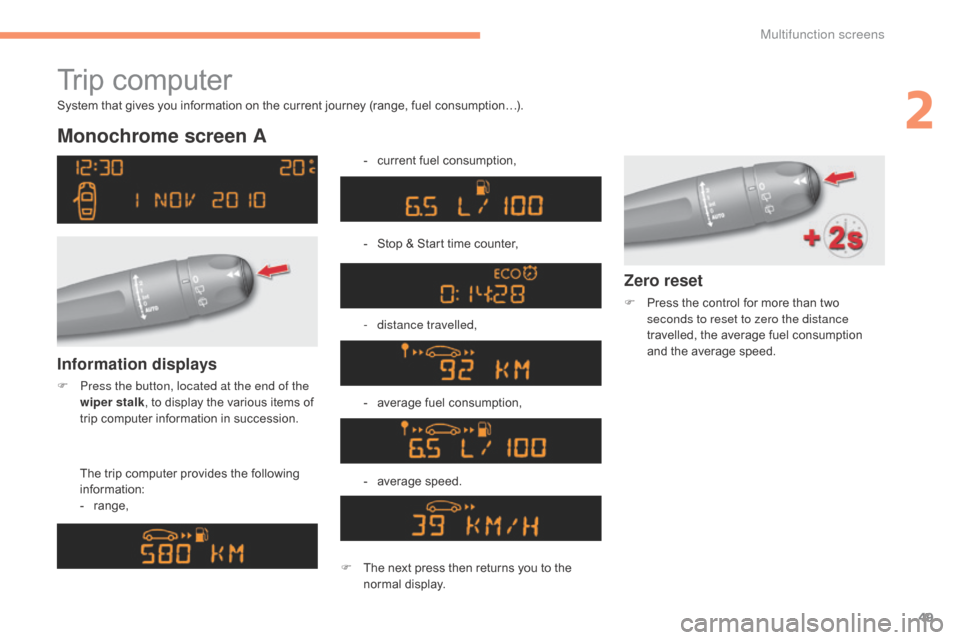
49
C4-2_en_Chap02_ecran-multifonction_ed01-2015
C4-2_en_Chap02_ecran-multifonction_ed01-2015
Tripô computer
Monochrome screen A
ô Theô trip ô computer ô provides ô the ô following ô i
nformation:
-
ô ra
nge, -
ô
c
urrent ô fuel ô consumption,
- ô
S
top ô & ô Start ô time ô counter,
-
d
istance travelled,
- ô
a
verage ô fuel ô consumption,
-ô a verageô s peed.
Information displays
F Press the button, located at the end of the
wiper stalk ,
ô to ô display ô the ô various ô items ô of ô
t
rip ô computer ô information ô in ô succession.
System
ô that ô gives ô you ô information ô on ô the ô current ô journey ô (range, ô fuel ô consumptionãÎ).
Zero reset
Fô Press
ô the ô control ô for ô more ô than ô two ô s
econds to reset to zero the distance
travelled,
ô the ô average ô fuel ô consumption ô
a
nd ô the ô average ô speed.
F
ô
T
he
ô
next
ô
press
ô
then
ô
returns
ô
you
ô
to
ô
the
ô
n
ormal
ô d
isplay.
2
Multifunction screens
Page 53 of 494
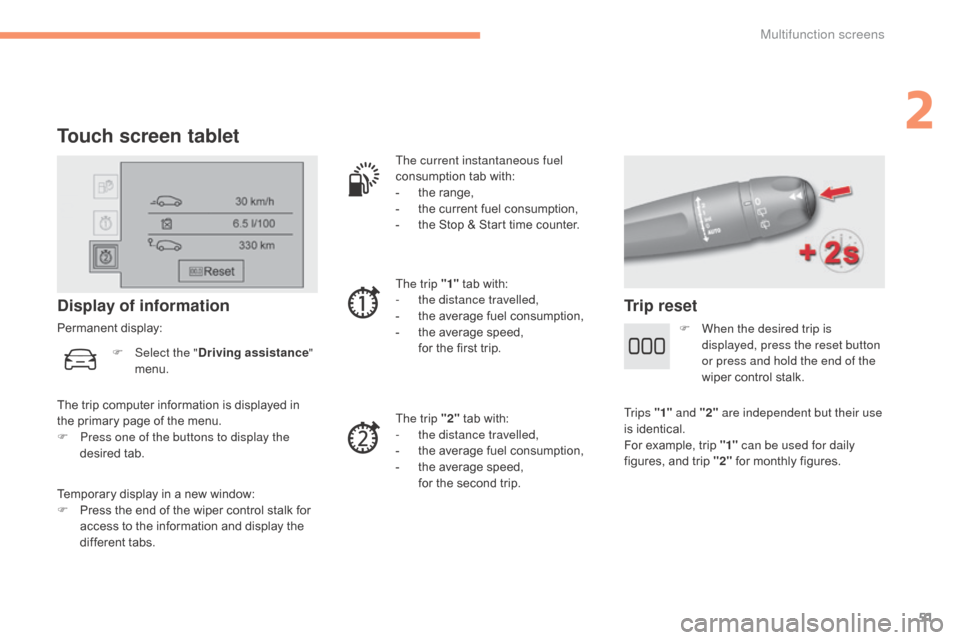
51
C4-2_en_Chap02_ecran-multifonction_ed01-2015
C4-2_en_Chap02_ecran-multifonction_ed01-2015
Touch screen tablet
Temporaryô displayô inô aô newô window:
F ô P ress ô the ô end ô of ô the ô wiper ô control ô stalk ô for ô
a
ccess ô to ô the ô information ô and ô display ô the ô
d
ifferent ô tabs.
Display of information
Permanentô display: The current instantaneous fuel
consumption
ô tab ô with:
- ô
t
he ô range,
- ô
t
he ô current ô fuel ô consumption,
- ô
t
he ô Stop ô & ô Start ô time ô counter.
The trip "1"
ô
tab ô with:
-
t
he distance travelled,
- ô t he ô average ô fuel ô consumption,
- ô t he ô average ô speed, ô
ô
f
or ô the ô first ô trip.
The trip "2"
ô
tab ô with:
-
t
he distance travelled,
-
ô
t
he ô average ô fuel ô consumption,
-
ô
t
he ô average ô speed, ô
ô
f
or ô the ô second ô trip.
Trip reset
Theô tripô computerô informationô isô displayedô inô the ô primary ô page ô of ô the ô menu.
F
P
ress one of the buttons to display the
desired
ô t
ab.
F
Sel
ect the "
Driving assistance "
menu. F
W
hen the desired trip is
displayed, press the reset button
or press and hold the end of the
wiper ô control ô stalk.
Tr i p s "1" and "2" are independent but their use
is
ô identical.
For
ô example, ô trip ô "1" can be used for daily
figures,
ô and ô trip ô "2"
ô
for ô monthly ô figures.
2
Multifunction screens
Page 54 of 494
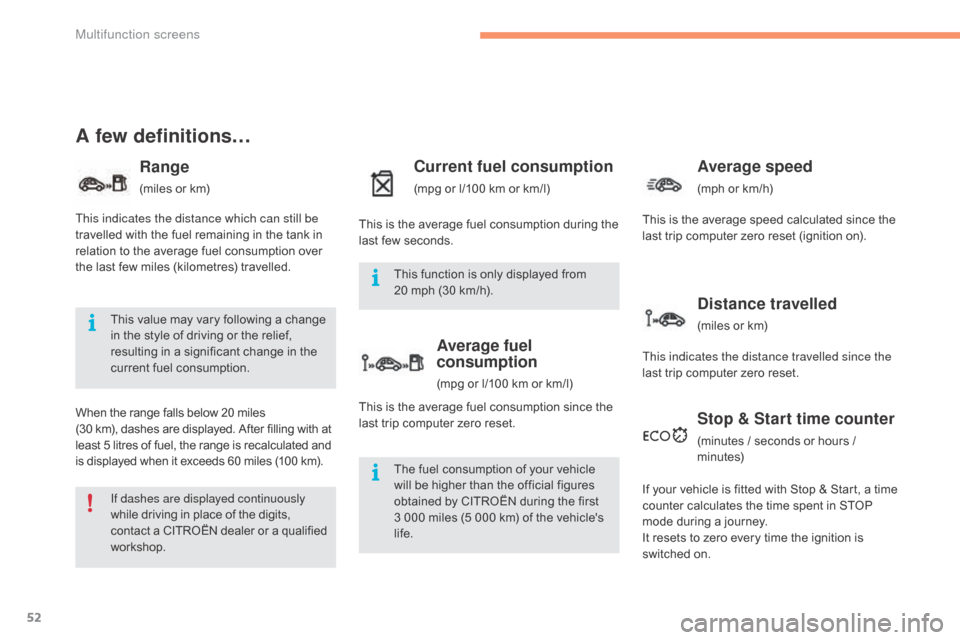
52
C4-2_en_Chap02_ecran-multifonction_ed01-2015
C4-2_en_Chap02_ecran-multifonction_ed01-2015
A few definitionsãÎ
Range
(milesô orô km)
W
hen
ô
the
ô
range ô falls ô below ô 20 ô miles
(30
ô
km),
ô
dashes ô are ô displayed. ô After ô filling ô with ô at
ô l
east
ô
5
ô
litres
ô of ô fuel, ô the ô range ô is ô recalculated ô and
ô i
s
ô
displayed
ô when ô it ô exceeds ô 60 ô miles ô (100 ô km).
Current fuel consumption
(mpgô orô l/100ô kmô orô km/l)
Average fuel
consumption
(mpgô orô l/100ô kmô orô km/l)
Average speed
(mphô orô km/h)
Distance travelled
(milesô orô km)
Stop & Start time counter
(minutesô /ô secondsô orô hoursô /ô minutes)
If dashes are displayed continuously
while
ô
driving
ô
in
ô
place
ô
of
ô
the
ô
digits,
ô c
ontact
ô
a
ô
CITROûN
ô
dealer
ô
or
ô
a
ô
qualified
ô w
orkshop. The
ô
fuel
ô
consumption
ô
of
ô
your
ô
vehicle
ô
w
ill
ô
be
ô
higher
ô
than
ô
the
ô
official
ô
figures
ô
o
btained
ô
by
ô
CITROûN
ô
during
ô
the
ô
first
ô
3
ô
000
ô
miles
ô
(5
ô
000
ô
km)
ô
of
ô
the
ô
vehicle's
ô
l
ife.
This
ô
function
ô
is
ô
only
ô
displayed
ô
from
ô
2
0ô mph
ô
(30
ô
km/h).
This
ô
value
ô
may
ô
vary
ô
following
ô
a
ô
change
ô
i
n
ô
the
ô
style
ô
of
ô
driving
ô
or
ô
the
ô
relief,
ô
r
esulting
ô
in
ô
a
ô
significant
ô
change
ô
in
ô
the
ô
c
urrent
ô
fuel
ô
consumption.
This indicates the distance which can still be
travelled
ô
with
ô
the
ô
fuel
ô
remaining
ô
in
ô
the
ô
tank
ô
in
ô
r
elation
ô
to
ô
the
ô
average
ô
fuel
ô
consumption
ô
over
ô
t
he
ô
last
ô
few
ô
miles
ô
(kilometres)
ô
travelled.
This
ô
is
ô
the
ô
average
ô
fuel
ô
consumption
ô
during
ô
the
ô
l
ast
ô
few
ô
seconds.
ô
ô
T
his
ô
is
ô
the
ô
average
ô
fuel
ô
consumption
ô
since
ô
the
ô
l
ast
ô
trip
ô
computer
ô
zero
ô
reset.
If
ô
your
ô
vehicle ô is ô fitted ô with ô Stop ô & ô Start, ô a ô time ô
c
ounter
ô
calculates ô the ô time ô spent ô in ô STOP ô
m
ode
ô
during ô a ô journey.
It
ô
resets
ô
to ô zero ô every ô time ô the ô ignition ô is ô
s
witched
ô
on.
This indicates the distance travelled since the
last
ô
trip
ô
computer ô zero ô reset.
This
ô
is
ô
the ô average ô speed ô calculated ô since ô the ô
l
ast
ô
trip
ô
computer ô zero ô reset ô (ignition ô on).
Multifunction screens
Page 183 of 494
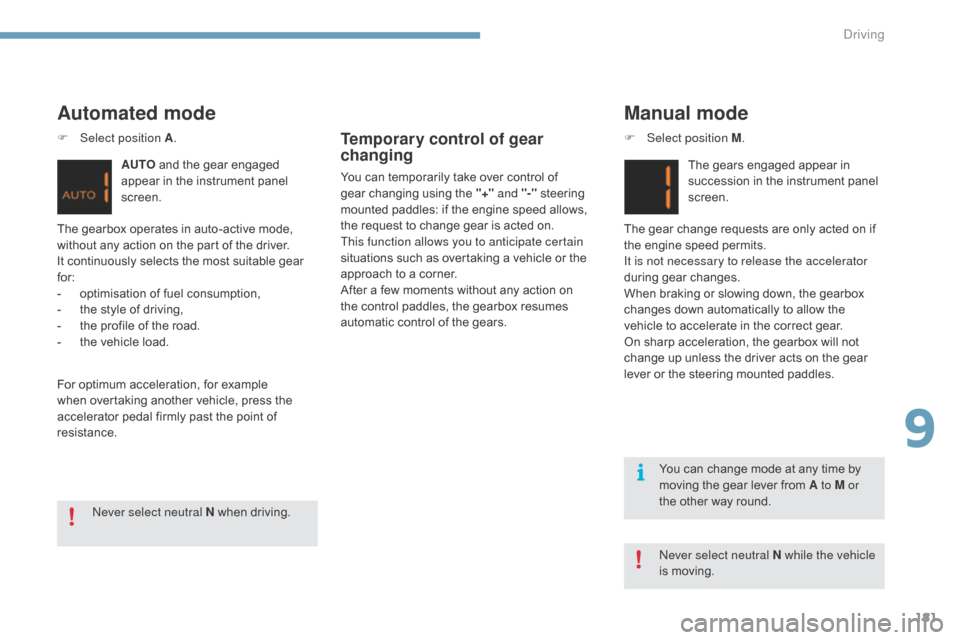
181
C4-2_en_Chap09_conduite_ed01-2015
C4-2_en_Chap09_conduite_ed01-2015
Automated mode
Forô optimumô acceleration,ô forô exampleô when ô overtaking ô another ô vehicle, ô press ô the ô
a
ccelerator ô pedal ô firmly ô past ô the ô point ô of ô
r
esistance.
The
ô gearbox ô operates ô in ô auto-active ô mode, ô
w
ithout ô any ô action ô on ô the ô part ô of ô the ô driver. ô
It ô continuously ô selects ô the ô most ô suitable ô gear ô
fo
r:
- ô
o
ptimisation ô of ô fuel ô consumption,
- ô
t
he ô style ô of ô driving,
- ô
t
he ô profile ô of ô the ô road.
- ô
t
he ô vehicle ô load.
AUTO
ô
and ô the ô gear ô engaged ô
a
ppear ô in ô the ô instrument ô panel ô
sc
reen.
ne
ver select neutral N while the vehicle
is
ô moving.
ne
ver select neutral N ô
w
hen
ô d
riving. You
ô can ô change ô mode ô at ô any ô time ô by ô
m
oving ô the ô gear ô lever ô from ô A to M or
the
ô other ô way ô round.
F
Sel
ect position A
.
Temporary control of gear
changing
Youô canô temporarilyô takeô overô controlô ofô g
ear ô changing ô using ô the ô "+" and "-"ô
steering ô
m
ounted ô paddles: ô if ô the ô engine ô speed ô allows, ô
t
he ô request ô to ô change ô gear ô is ô acted ô on.
This function allows you to anticipate certain
situations
ô such ô as ô overtaking ô a ô vehicle ô or ô the ô
a
pproach ô to ô a ô corner.
After
ô a ô few ô moments ô without ô any ô action ô on ô
t
he ô control ô paddles, ô the ô gearbox ô resumes ô
a
utomatic ô control ô of ô the ô gears.
Manual mode
Theô gearsô engagedô appearô inô succession ô in ô the ô instrument ô panel ô
sc
reen.
The
ô
gear
ô
change ô requests ô are ô only ô acted ô on ô if ô
t
he
ô
engine
ô
speed ô permits.
It is not necessary to release the accelerator
during
ô
gear
ô changes.
When
ô
braking ô or ô slowing ô down, ô the ô gearbox ô
c
hanges
ô
down ô automatically ô to ô allow ô the ô
v
ehicle
ô
to
ô
accelerate ô in ô the ô correct ô gear.
On
ô
sharp
ô
acceleration, ô the ô gearbox ô will ô not ô
c
hange
ô
up
ô
unless ô the ô driver ô acts ô on ô the ô gear ô
l
ever
ô
or
ô
the
ô steering ô mounted ô paddles.
F
Sel
ect position M
.
9
Driving
Page 189 of 494
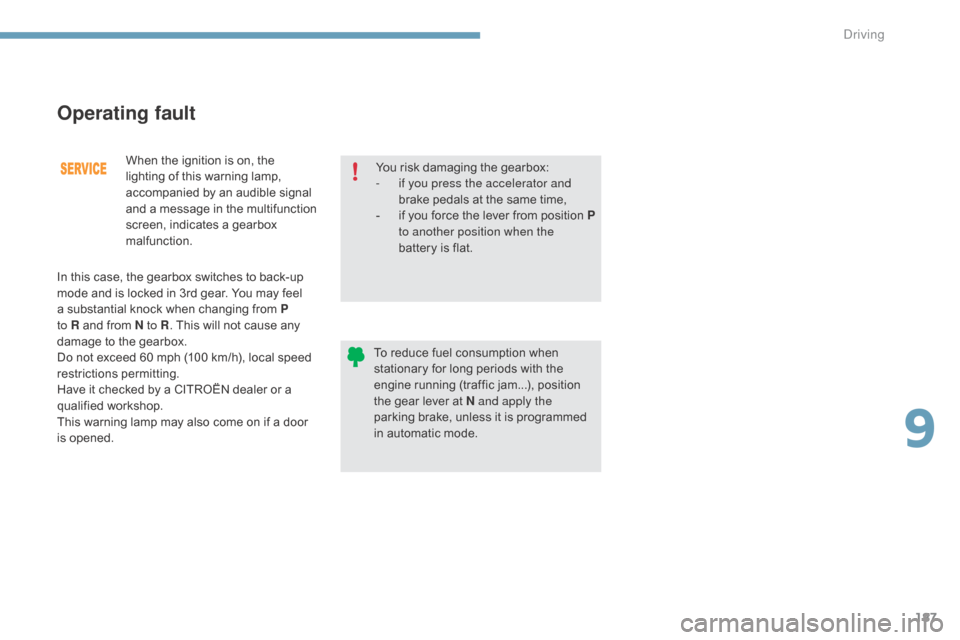
187
C4-2_en_Chap09_conduite_ed01-2015
C4-2_en_Chap09_conduite_ed01-2015
Whenô theô ignitionô isô on,ô theô lighting ô of ô this ô warning ô lamp, ô
a
ccompanied ô by ô an ô audible ô signal ô
a
nd ô a ô message ô in ô the ô multifunction ô
s
creen, ô indicates ô a ô gearbox ô
m
alfunction.
Operating fault
Youô riskô damagingô theô gearbox:
- i f you press the accelerator and
brake
ô pedals ô at ô the ô same ô time,
-
ô
i
f ô
y
ou ô
f
orce ô
t
he ô
l
ever ô
f
rom ô
p
ositionô P
to another position when the
battery
ô is ô flat.
To
ô reduce ô fuel ô consumption ô when ô
s
tationary ô for ô long ô periods ô with ô the ô
e
ngine ô running ô (traffic ô jam...), ô position ô
t
he ô gear ô lever ô at ô N and apply the
parking
ô brake, ô unless ô it ô is ô programmed ô
i
n ô automatic ô mode.
In
ô
this
ô
case,
ô
the
ô
gearbox
ô
switches
ô
to
ô
back-up
ô
m
ode
ô
and
ô
is
ô
locked
ô
in
ô
3rd
ô
gear.
ô
You
ô
may
ô
feel
ô
a
ô
substantial
ô
knock
ô
when
ô
changing
ô
from
ô
P
to R
ô
and
ô
from
ô
N to R .
ô
This
ô
will
ô
not
ô
cause
ô
any
ô
d
amage
ô
to
ô
the
ô
gearbox.
Do
ô
not
ô
exceed
ô
60
ô
mph
ô
(100
ô
km/h),
ô
local
ô
speed
ô
r
estrictions
ô p
ermitting.
Have
ô
it
ô
checked
ô
by
ô
a
ô
CITROûN
ô
dealer
ô
or
ô
a
ô
q
ualified
ô w
orkshop.
This
ô
warning
ô
lamp
ô
may
ô
also
ô
come
ô
on
ô
if
ô
a
ô
door
ô
i
s
ô ope
ned.
9
Driving
Page 191 of 494

189
C4-2_en_Chap09_conduite_ed01-2015
C4-2_en_Chap09_conduite_ed01-2015
Gear shift indicator*
Dependingô onô theô drivingô situationô andô yourô vehicle's ô equipment, ô the ô system ô may ô advise ô
y
ou ô to ô skip ô one ô (or ô more) ô gear(s). ô You ô can ô
f
ollow ô this ô instruction ô without ô engaging ô the ô
i
ntermediate
ô g
ears.
The
ô gear ô engagement ô recommendations ô must ô
n
ot ô be ô considered ô compulsory. ô In ô fact, ô the ô
c
onfiguration ô of ô the ô road, ô the ô amount ô of ô traffic ô
a
nd ô safety ô remain ô determining ô factors ô when ô
c
hoosing ô the ô best ô gear. ô Therefore, ô the ô driver ô
r
emains ô responsible ô for ô deciding ô whether ô or ô not ô
t
o ô follow ô the ô advice ô given ô by ô the ô system.
This
ô function ô cannot ô be ô deactivated. -
ô
Y
ou ô press ô the ô accelerator ô pedal.
Example:
-
ô Y ou ô are ô in ô third ô gear.
-
ô
T
he ô system ô may ô suggest ô that ô you ô engage ô
a
ô higher ô gear.
The
ô information ô appears ô in ô the ô instrument ô p
anel ô in ô the ô form ô of ô an ô arrow.
System
ô which ô reduces ô fuel ô consumption ô by ô recommending ô the ô most ô appropriate ô gear.
With ô an ô electronic ô or ô automatic ô gearbox, ô the ô
s
ystem ô is ô only ô active ô in ô manual ô mode.
*
ô Depending ô on ô engine. On
ô vehicle ô fitted ô with ô a ô manual ô gearbox, ô
t
he ô arrow ô may ô be ô accompanied ô by ô the ô gear ô
re
commended.The
ô system ô adapts ô its ô gear ô change ô
r
ecommendation ô according ô to ô the ô
d
riving ô conditions ô (slope, ô load,ô ...) ô and ô
t
he ô demands ô of ô the ô driver ô (power, ô
a
cceleration, ô braking,ô ...).
The
ô system ô never ô suggests:
-
ô
e
ngaging ô first ô gear,
-
ô enga
ging
ô r
everse
ô g
ear,
Operation
Onô BlueHDiô Dieselô versionsô withô manualô gearbox, ô t he ô s ystem ô m ay ô s uggest ô c hanging ô i nto ô
n
eutral ô so ô that ô the ô engine ô can ô go ô into ô standby ô
(
STOP ô mode ô with ô Stop ô & ô Start), ô in ô certain ô
d
riving ô conditions. ô In ô this ô case, ô N is displayed
in
ô the ô instrument ô panel.
9
driving
Page 192 of 494

190
C4-2_en_Chap09_conduite_ed01-2015
C4-2_en_Chap09_conduite_ed01-2015
Tyreô under-inflationô detection
Systemô whichô automaticallyô checksô theô p
ressures ô of ô the ô tyres ô while ô driving.
The
ô system ô continuously ô monitors ô the ô
p
ressures of the four tyres, as soon as the
vehicle
ô is ô moving.
a
pressure sensor is located in the valve of
each
ô tyre ô (except ô the ô spare ô wheel).
The
ô system ô triggers ô an ô alert ô if ô a ô drop ô in ô
p
ressure ô is ô detected ô in ô one ô or ô more ô tyres.
The
ô tyre ô under-inflation ô detection ô system ô is ô an ô
a
id ô to ô driving ô which ô does ô not ô replace ô the ô need ô
f
or ô vigilance ô on ô the ô part ô of ô the ô driver.This
ô system ô does ô not ô avoid ô the ô need ô
t
o ô check ô the ô tyre ô pressures ô regularly ô
(
including ô the ô spare ô wheel) ô and ô before ô
a
ô long ô journey.
Driving ô with ô under-inflated ô tyres ô
a
dversely ô affects ô road ô holding, ô
e
xtends ô braking ô distances ô and ô causes ô
p
remature ô tyre ô wear, ô particularly ô under ô a
rduous ô conditions ô (vehicle ô loaded, ô h
igh ô speed, ô long ô journey).The tyre pressures for your vehicle can
be
ô found ô on ô the ô tyre ô pressure ô label ô (see ô
t
he ô "Identification ô markings" ô section).
The ô tyre ô pressures ô must ô be ô checked ô
w
hen ô the ô tyres ô cold ô (vehicle ô stopped ô
f
or ô 1 ô hour ô or ô after ô driving ô for ô less ô then ô
6
ô miles ô (10 ô km) ô at ô moderate ô speed). ô
O
ther wise, ô add ô 0.3 ô bar ô to ô the ô values ô i
ndicated ô on ô the ô label.
Driving ô with ô under-inflated ô tyres ô
i
ncreases ô fuel ô consumption.
driving